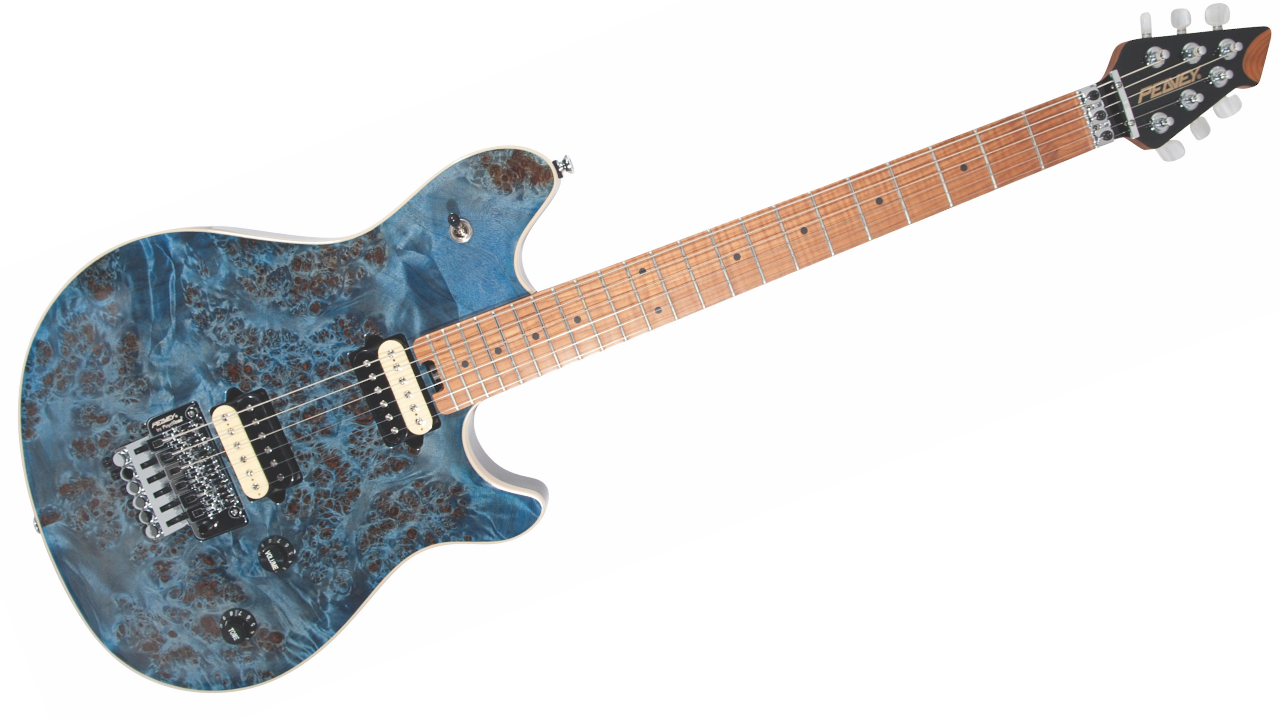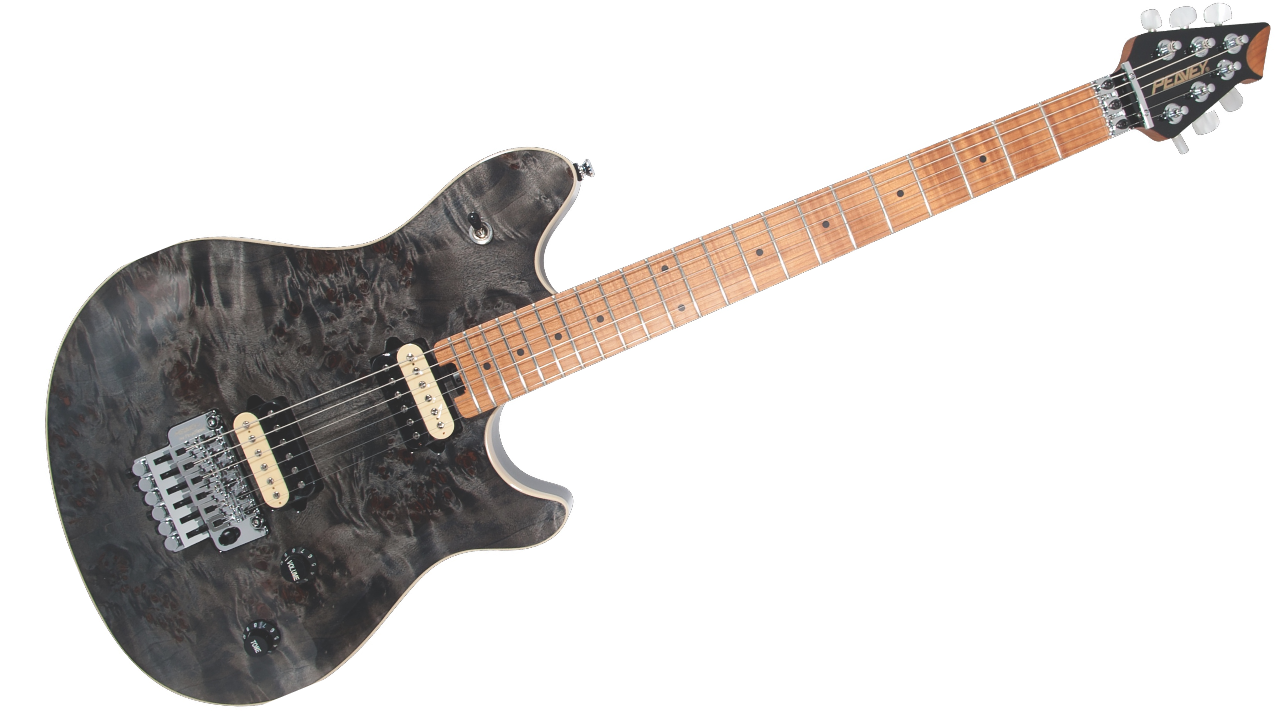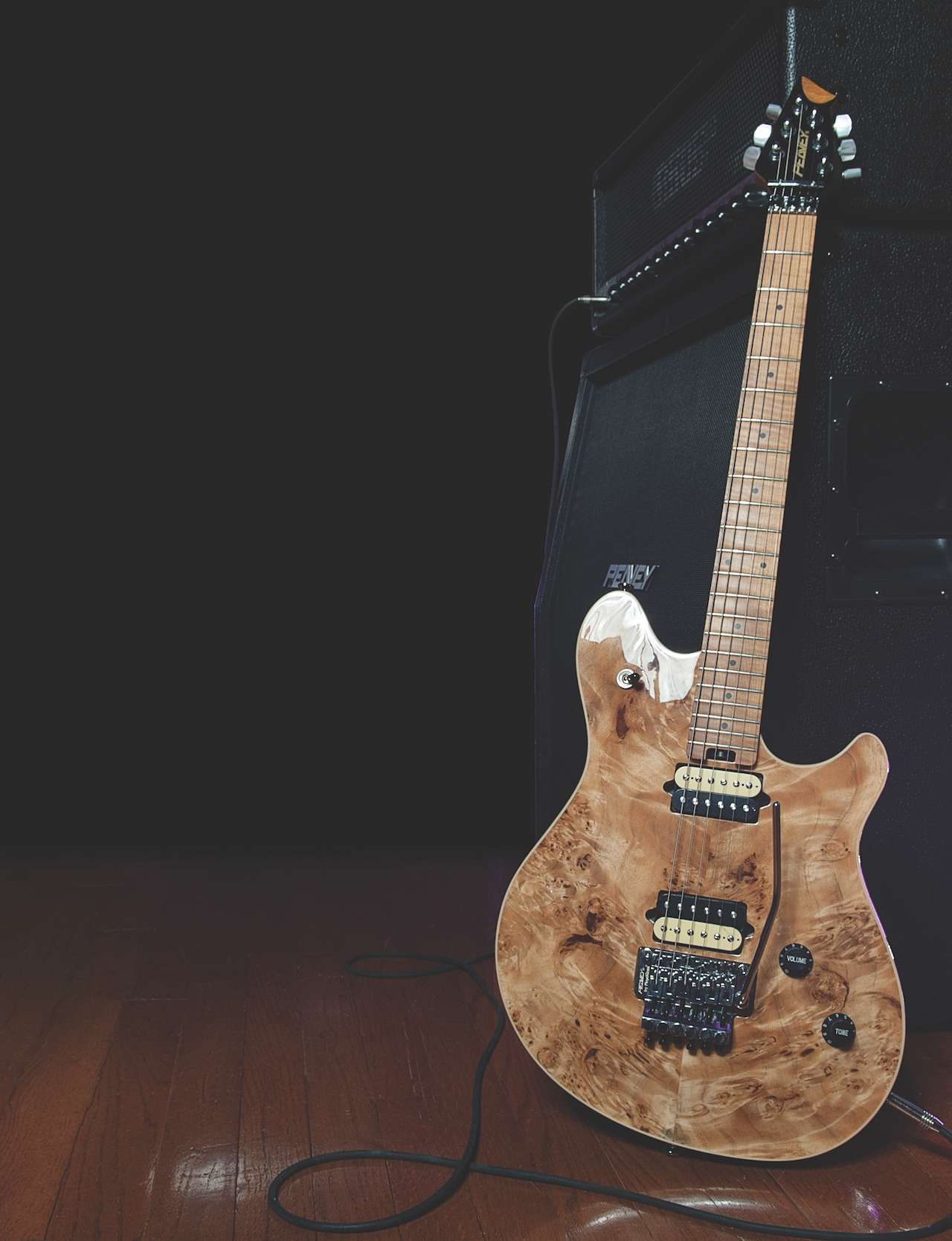GuitarPlayer Verdict
if you need to rock large, it’s an axe to check out, and one that offers the flexibility to segue into other realms while you’re awaiting your big solo
Pros
- +
A powerful rock guitar primed to ably nail the expectations of the breed, with decent versatility besides, and the exotic beauty of a burled top
Cons
- -
Might be considered pricey by some players
You can trust Guitar Player.
One glance at Peavey’s new HP 2 Poplar Burl RM tells you it’s primed to rock, with its double-locking vibrato, dual humbuckers and no-nonsense control layout. Likely the same glance also tells you it’s a direct descendant of Peavey’s best-known and most historic rock axe of all time, the Wolfgang.
The company, based in Meridian, Mississippi, manufactured that Edward Van Halen signature model between 1996 and 2004, prior to the virtuoso shredder’s split from the deal to make guitars and amplifiers under his own EVH brand, beginning in 2007. Few guitarists missed the similarity between the designs when Peavey introduced its first HP 2 in 2017. Now the HP 2 Poplar Burl RM adds to the formula with an exotic top carved from solid burled poplar, in your top-finish choice of Natural, Transparent Blue or Transparent Black, as on our review sample.
The design’s pedigree and decades-long history of manufacture has been seen in undeniably similar electric guitars by three different companies, starting with the Axis from Ernie Ball/Music Man and continuing to the Peavey Wolfgang, the EVH model and Peavey’s HP 2.
Not surprisingly, the HP 2 Poplar Burl RM’s standout features and specifications are likely to be familiar to the majority of players interested in what a streamlined, hard-charging beast like this has to offer. But Peavey has put its own stamp on the formula, and it’s worth detailing what this new iteration brings to the table.
The “HP” in the name stands for Hartley Peavey, and the company is quick to point to the founder’s initials as a declaration of quality. That’ll cost you some bread, too, considering the price point of just under $3k (and the website shows that as a 25 percent discount off the official list price of $3,999).
Although that might outwardly seem a little steep for an offshore-built guitar, Peavey tells us the instrument’s “handcrafted in the Czech Republic” origins represent no compromise in quality or components. The area of Europe where these guitars are made has some of the finest luthiers to be found, and many of the world’s most expensive violins come from this region.
The carved two-piece poplar burl top exhibits plenty of characterful, semi-random swirling and streaking beneath the transparent gloss-black finish. They’re all characteristics of this wood, which is sourced from stress or deformation in the host tree, and which has become more and more popular with makers seeking exotic alternatives in recent years (via a range of species, not only poplar). Beneath it, a body made from solid basswood is finished in opaque black, with single-ply off-white binding around the top to set it off.
All the latest guitar news, interviews, lessons, reviews, deals and more, direct to your inbox!

In split-coil mode, the HP 2 absolutely shines for pristine rhythm work or shimmery ballad-friendly arpeggios
The 22-fret, bolt-on neck is carved from a lovely piece of subtly flamed and tightly grained roasted maple, with its top sliced off and reapplied as the fingerboard after truss-rod installation, built to a 25 ½–inch scale length and sporting a 15-inch radius.
In addition to the truss rod with body-end adjustment wheel, the construction is reinforced with graphite for added stability, and its hand-rubbed oil finish feels great in the palm, revealing a fast but naturally woody texture that further enhances the comfortable modified-C profile. The diminutive scooped headstock sits at a 10-degree back angle behind a locking nut and string-tension bar, with slightly offset three-a-side Schaller Mini tuners with pearloid buttons.
Partnering this configuration at the other terminal end is a Floyd Rose-licensed vibrato, which, alongside the dual humbuckers, really comprises the engine room of this longrunning design. Recessed into the body’s top and primed for deepest dive-bomb action, it’s loaded with the requisite fine tuners for attaining pitch perfection once the other end is locked and loaded.
The two Peavey-designed humbucking pickups are mounted directly to the guitar’s body and wound hot, as you might expect, at around 12k-ohms in the neck position and 15k-ohms in the bridge. They’re wired through a three-way Switchcraft toggle selector and the volume and tone potentiometers, with push-pull switching to split the coils of the pickup in each relative position.
Tested through a Friedman Small Box head and 2x12 cab, plus several higher-gain presets on a Neural DSP Quad Cortex into studio monitors, the HP 2 Poplar Burl RM rocked every bit as mightily as its features and format promised. To bill it as a one-trick pony, however, would be a mistake, and in use this design, which descended from the very heart of a rock guitar revolution, displayed impressive versatility.
At first, without employing a little lateral thinking, it might be easy to find this HP 2’s clean tones a little underwhelming and simply conclude, “Well, that’s not what it was built for.” In full-humbucking mode even my most lightly driven amp and patch settings sounded a little woolly and dull, and winding down the guitar’s volume control didn’t help a lot.

But pop up either control knob to send its relative pickup into split-coil mode, and the HP 2 absolutely shines for pristine rhythm work or shimmery ballad-friendly arpeggios, and with more beef and substance than many humbuckers display while coil-split, thanks to the overwound coils that kick off the design. In the middle position, the dual-split setting also revealed some richly funky, semi-scooped tones with a lot of potential, while mixing and matching split with full humbucking in either direction further extended the sonic scope.
Rather surprisingly, the splits also performed extremely well into high gain, where so many will slur into an overly bright, ice-picky mess. As such, they deliver a more tightly, brightly focused breed of lead tone that retains note definition through the blur.
Of course, for archetypal heavy rock and metal, the full-humbucking mode is where it’s at with this thing, and the power, sustain and gain-driving dynamics of this design really come into their own when you’re pushing it full bore. Although I’m not that kind of player as a daily driver, the HP 2 Poplar Burl RM quickly had me enjoying the fleetfingered hammer-ons, gut-thumping power-chord chug, stinging pinched harmonics and singing sustain to no end, and with surprisingly little effort once I’d slid back into that style of playing.
Tuning stability was also excellent, even through considerable vibrato use, and I tweaked the fine tuners only slightly, now and then, after a spate of dive bombing.
Ultimately, the HP 2 Poplar Burl RM might not be your first choice of guitar if clean pop, indie rock, roots rock or edge-of-breakup blues are your thing, and to be fair that’s not what it’s designed for. But if you need to rock large, it’s an axe to check out, and one that offers the flexibility to segue into other realms while you’re awaiting your big solo.

Specifications
- NUT: Metal locking, 1 5/8” wide
- NECK: Maple, modified “C” profile
- FRETBOARD: Maple, 25.5” scale, 15” radius
- FRETS: 22 medium-jumbo TUNERS: Schaller Mini
- BODY: Solid basswood body with carved poplar burl top
- BRIDGE: Floyd Rose licensed vibrato
- PICKUPS: Two Peavey designed high-output humbuckers
- CONTROLS: Volume and tone with push-pull switching for coil splitting, three-way selector switch
- FACTORY STRINGS: D’Addario .010–.046
- WEIGHT: 8.6 lbs
- BUILT: Czech Republic
Dave Hunter is a writer and consulting editor for Guitar Player magazine. His prolific output as author includes Fender 75 Years, The Guitar Amp Handbook, The British Amp Invasion, Ultimate Star Guitars, Guitar Effects Pedals, The Guitar Pickup Handbook, The Fender Telecaster and several other titles. Hunter is a former editor of The Guitar Magazine (UK), and a contributor to Vintage Guitar, Premier Guitar, The Connoisseur and other publications. A contributing essayist to the United States Library of Congress National Recording Preservation Board’s Permanent Archive, he lives in Kittery, ME, with his wife and their two children and fronts the bands A Different Engine and The Stereo Field.

